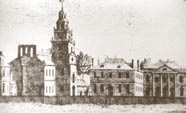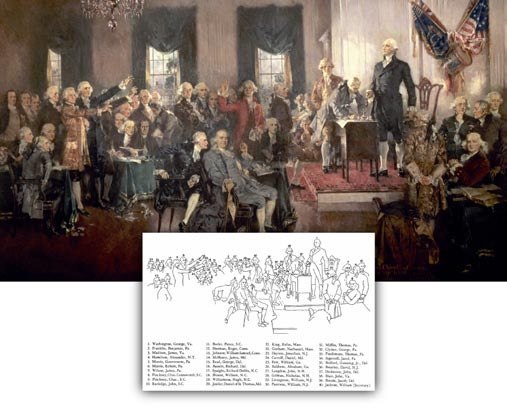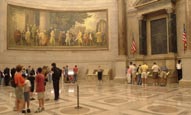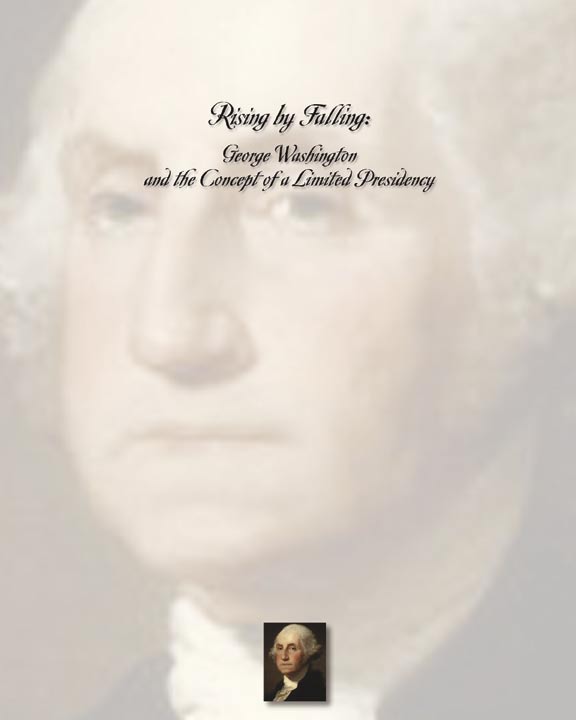making treaties or borrowing money. Amendments to
semble “for the sole and express purpose of revising the
the Articles required the assent of all the states, giving
Articles of Confederation” and reporting to Congress re-
every state a liberum veto, that is, sufficient veto power
visions which would become effective only when agreed
to paralyze democratic process. Tiny Rhode Island could
to in Congress and confirmed by the states.
thus thwart the will of the other 12 states – as it did in
vetoing a proposal to give Congress the power to levy
James Madison and the
duties on imports.
In particular, commercial rivalries spawned trade
Virginia Plan
discrimination among the states. Landlocked states
found themselves at a notable disadvantage, dependent
In spite of the innate conservatism of the states, how-
upon states with good seaports. James Madison likened
ever, once assembled, the convention proved decisive.
New Jersey, situated between New York and Philadel-
A remarkable group of 55 men assembled in Philadelphia
phia, to “a cask tapped at both ends,” and North Caro-
in May 1787. Their grasp of issues had been honed by
lina, between the deep harbors of Hampton Roads and
wide experience in public life – over half had served in
Charleston, to “a patient bleeding at both arms.” The
Congress, seven had been state governors, and a num-
feebleness of the central government was further high-
ber had been involved in writing state constitutions.
lighted by the lack of executive or
George Washington, the general from
judicial power to deal with domestic
Virginia who had led the war against
disorder. For example, beginning in
the British, brought special prestige
1786, during a period of economic
to the gathering when he agreed to
depression, mobs of impoverished
serve as its presiding officer. Other
farmers in western Massachusetts
notables included Alexander Hamil-
prevented the courts from func-
ton (New York), Benjamin Franklin
tioning and ordering foreclosures.
(Pennsylvania), and James Wilson
Daniel Shays, a farmer and former
(Pennsylvania). Perhaps the most
revolutionary officer, led a force
conspicuous absence was Thomas
attempting to seize the arsenal at
Jefferson, who had drafted the
Springfield but was repulsed. In
Declaration of Independence but
general, perhaps no flaw in the
who was now serving as the United
Articles was as glaring as the in-
States’ minister to Paris.
ability of the central government to
It soon became apparent that the
act directly upon individuals, rather
most important and respected voice
than hope for the states to act.
at the convention was that of James
In 1785,Virginia and Maryland
Madison, of Virginia. Active in Vir-
appointed commissioners to settle
ginia politics, Madison had acquired
disputes over uses of the Chesa-
Signed in 1787, the Constitution of the United States helped a national reputation as a member of peake Bay and its tributary rivers.
create modern democracies worldwide.
the Continental Congress, where he
These delegates then called for the
was instrumental in bringing about
states to be invited to discuss whether a more “uniform
Virginia’s cession of its claim to western territories, creat-
system” of trade regulation might be in their “common
ing a national domain. Madison became increasingly
interest.” Congress responded by calling a meeting at
convinced that the liberty of Americans depended on the
Annapolis in 1786. Only five states attended that meet-
Union’s being sufficiently strong to defend them from
ing, and its members recommended that there should be
foreign predators and, at home, to offset the excesses of
a constitutional convention in Philadelphia to consider
popular government in the individual states. No one
what should be done “to render the constitution of the
came to Philadelphia better prepared. He had taken
federal government adequate to the exigencies of the
the lead in seeing that the nation’s best talent was at the
Union. ...” Virginia took the lead in appointing a delega-
convention. Moreover, in the weeks before the meet-
tion, and other states followed suit, forcing Congress’s
ing, he had read deeply in the experiences of ancient
hand. Finally, in February 1787, Congress endorsed
and modern confederacies and had written a memo-
the calling of a convention. Significantly, however,
randum on the “Vices of the Political System of the
Congress’s resolution said that the convention should as-
United States.” First to arrive in Philadelphia, Madison
11

persuaded Virginia’s delegation to propose a plan which,
The Great Compromise and
far from simply revising the Articles, would replace them
with a national government of sweeping powers. Deriv-
Other Compromises
ing its authority from the people, Congress would have
the power “to legislate in all cases to which the separate
States are incompetent, or in which the harmony of the
On June 13, the Virginia Plan, with some revisions,
United States may be interrupted by the exercise of indi-
was reported out of the Committee of the Whole.
vidual Legislation.” Further departing from the Articles,
On June 15, Paterson, speaking for the plan’s opponents,
the Virginia Plan called for the new Constitution to be
introduced the New Jersey Plan. Under this plan, each
ratified, not by the state legislatures, but by conventions
state would have an equal vote in a unicameral Congress.
elected by the people of the several states.
Resolving themselves once again into a Committee
Resolving themselves into a Committee of the Whole,
of the Whole, the delegates debated the merits of the
the delegates debated the merits of the Virginia Plan.
Virginia and New Jersey Plans. On June 19, the commit-
Those urging an expansion of national powers, led by
tee voted, seven states to three (with Maryland divided),
Madison and James Wilson, thought it essential to scrap
to stay with the Virginia Plan. The matter remained
the unworkable system of a central government at-
unresolved, with votes settling into a pattern of six states
tempting to effect policy through the states. Instead,
(Massachusetts, Pennsylvania, Virginia, the Carolinas,
they asserted, the national government must operate
and Georgia) against Connecticut, New York, New Jer-
directly on individuals and, through its executive and
sey, and Delaware, with Maryland divided. In late June,
judicial branches, be able to enforce its laws and decrees.
Connecticut’s Oliver Ellsworth proposed a compromise
Principles of individual equality, moreover, called for
– population to be the basis for representation in one
representation in Congress to be based on population,
house, the states to have equality in the other.
thus abandoning parity among the states. Madison and
In early July, the convention voted on Connecticut’s
his allies were hoping to build upon a sense, widely held
proposal for state equality in the senate, but the motion
among the delegates, that ad hoc or piecemeal reform of
failed on an equal division (with Georgia divided). The
the existing system would no longer suffice.
convention appeared to have arrived at deadlock. Look-
Radical reform was, however, too bold for many
ing for a way out of the predicament, South Carolina’s
delegates from the smaller states. While they might
Charles C. Pinckney asked for the appointment of a
concede the need for enlarging the powers of the cen-
grand committee. That committee then ratified what has
tral government, including giving it the power to raise
come to be called the Great Compromise – proportional
its own revenue and to regulate commerce, the smaller
representation in the lower house, states’ equality in
states feared domination by the large states. The central
the upper house. Even while the larger states preferred
question was that of representation. New Jersey’s William
representation based on population as the basic rule,
Paterson insisted that his state could “never confeder-
some of their delegates preferred compromise to risking
ate on the plan before the committee.” With Madison
a walkout by small state delegates. Virginia’s George
and Wilson continuing to insist on a nationalist plan, it
Mason said that he would “rather bury his bones” in
seemed possible that the convention delegates, whatever
Philadelphia than see the convention dissolved without
their agreement on other matters, might founder on the
agreement upon a plan of government. On July 16, the
issue of representation.
convention voted for the compromise, five states in favor,
four opposed, one divided (with New York not present).
Notwithstanding grumbling by some delegates from
the larger states, the most contentious issue had now
been resolved, and the convention could move on to
other questions. Election of the executive proved a
thorny issue. The Virginia Plan had provided for an
executive elected by the legislature; this, however, would
create a dependent executive branch – a defect of many
of the state constitutions. Few delegates were so bold as
to suppose that direct election by the people was a wise
move. Ultimately, the convention opted for a device – an
awkward one to the modern mind – of having an elector-
12


al college choose the president. Each state was entitled,
of rights that would specify and protect the rights of in-
by whatever method it pleased, to select electors equal
dividual citizens. Others argued, however, that nothing
in number to the number of that state’s senators and rep-
in the Constitution would infringe the rights guaranteed
resentatives. The electors would meet in their respective
in the state constitutions. Mason’s proposal was rejected,
states and vote for the president and vice president. The
although it would be revived during the ratification
subsequent rise of political parties, however, has ended
debates.
the framers’ notion that electors would actually deliber-
The convention was moving to its conclusion. On
ate on their choices for national leadership.
September 17, Benjamin Franklin, at age 81 the con-
On July 24, the convention appointed five members to
vention’s patriarch, pleaded with anyone who had some
a Committee of Detail, whose job it was to draft an ac-
reservations about the meeting’s product to “doubt a
tual constitution embodying the fundamental principles
little of his own infallibility.” Looking ahead to the rati-
thus far approved by the whole body. The committee’s
fication process, the Constitution’s proponents wanted
members seem to have assumed that they were at liberty
a unanimous result. Of the 42 members (of the original
to make substantive changes of their own. The most
55) still present on September 17, all but three signed
important of these was, in place of a general statement
the final document. As representatives from each state
of Congress’s powers, a clear enumeration of its powers.
had concurred in the result, Gouverneur Morris devised
Leading the list were the power to
the formula “Done in Convention
tax and the power to regulate inter-
by the Unanimous Consent of the
state and foreign commerce – two of
States present” on that date.
the basic reasons that had brought
the delegates to Philadelphia in the
first place.
How the Federalist
Sectional differences surfaced
during the convention’s latter
Papers Persuaded
weeks. Southern states, depen-
dent on the export of agricultural
a Nation
commodities, wanted to forbid
Philadelphia, birthplace of the Constitution, 1787.
Congress’s taxing exports, and they
Following the course set out in
wanted to protect slavery and the slave trade. In late Au-
the Virginia Plan, the Philadel-
gust, the convention agreed to a ban on taxes on exports
phia convention proposed having the people elect state
and a prohibition on interference with the slave trade
conventions to pass upon the proposed Constitution.
until the year 1808. Slavery was the unwelcome guest at
After some hesitation, the expiring Continental Con-
the convention’s table. Nowhere does the Constitution
gress forwarded the Constitution to the states for their
use the word “slave” or “slavery.” In language intended
approval. Once again, as before and during the 1787 con-
to compromise competing southern and northern views
vention, Madison took the leading role. Knowing that
on representation, the convention decided that, in appor-
ratification in Pennsylvania, Massachusetts, and Virginia
tioning representatives, to the number of “free Persons”
was critical, Madison helped orchestrate the convening
should be added three-fifths of “all other Persons” – that
of the state meetings. Several small states, Delaware
is, slaves. Some of the delegates thought slavery a blot
leading the way, acted quickly, but, as time passed, oppo-
on the nation’s moral conscience, but they concluded,
nents – known as the anti-Federalists – began to mount
reluctantly, that a stronger stand on slavery would mean
their own campaign. Chief among their complaints were
rejection of the proposed Constitution in the southern
the failure to include a bill of rights and the fear that a
states and thus the prospect of the Union’s dissolution.
“consolidated” government would swallow up the states.
How to resolve the burning issue of slavery was thus
In carrying Massachusetts, the Federalists acceded
postponed, to be settled decades later by civil war and
to recommendations for amendments which could be
reconstruction.
added after ratification was complete.
On September 8, a Committee on Style was appointed
New York seemed especially fertile ground for the
to polish the Constitution’s language and to arrange its
anti-Federalists. Madison, Hamilton, and John Jay
articles. When that committee reported, George Ma-
wrote a series of essays, published in New York news-
son, the author of Virginia’s 1776 Declaration of Rights,
papers, making the case for ratification. These essays,
argued that the federal document should also have a bill
subsequently collected and published as the famous
13


Federalist Papers, stand as the classic exposition of the
Washington was sworn in as the first president of the
foundations of constitutional government in the United
United States.
States. In Virginia, Madison, joined by John Marshall
Implicit in the Federalists’ campaign for the Constitu-
and Edmund Randolph, had to fend off a sharp attack
tion was an understanding that a bill of rights – provi-
on the new Constitution draft led by Patrick Henry and
sions clarifying the rights of individuals in the new nation
George Mason. The result there was a close one, 89-79.
– would be added when the new government got under
New York, where Governor George Clinton and his allies
way. As a member of the House of Representatives in the
bitterly opposed the Constitution, ratified by an even
first Congress, Madison moved to redeem that implicit
closer vote, 30-27. In eight months, all but two states had
pledge by proposing a list of amendments to be submit-
approved the Constitution. Eventually North Carolina
ted to the states. Sifting the various proposals which
(in 1789) and even Rhode Island (in 1790) ratified. In the
had come out of the ratifying conventions, Madison
meantime, in September 1788, the Continental Congress
produced the amendments which, as ratified, became
resolved that the new Constitution should be put into
the Constitution’s first 10 amendments – what we call
effect. In January 1789, the first presidential electors
the Bill of Rights. Chief among these are protections for
met in the several states, and their unanimous choice for
free speech and press, freedom of religion, guarantees
president was George Washington. In April 1789,
of fairness in criminal trials, and the admonition that the
In this 20th-century oil painting of the Constitution’s signing, George Washington dominates the scene on the right.
Foreground: Benjamin Franklin, with Alexander Hamilton whispering in his ear.
14


listing of specific rights was not to be read as precluding
dividual liberty. Limited government finds handmaidens
the existence of other rights retained by the people – a
in Madisonian concepts such as separation of powers and
reflection of “higher law” thinking, which, in the 18th
checks and balances – that is, the apportionment of real
century, implied that people had certain “natural” rights.
power and authority among the executive, the legislative,
and judicial branches of government.
An Adaptable Document
4. Partly through practical compromise, the Constitu-
tion aims at creating a central government with sufficient
The Constitution’s influence was immediately felt
energy, while preserving citizens’ ability to speak to local
beyond the borders of the United States. The
issues at the local level. Federalism in its various forms
adoption of a written constitution became intrinsically
(such as devolution) – that is, the retention of viable state
identified with aspirations to self-government. On
and local governments as well as the structure of a federal
May 3, 1791, Poland produced Europe’s first written
government – has proved increasingly attractive as a way
constitution, followed soon thereafter by France. Not
of balancing national and local needs in many nations.
surprisingly the American experience was often cited
Various reasons account for the success of the 1787
in other countries’ debates on the drafting of their own
convention. Disagreeing on some important issues, the
constitutions. In Germany, for
delegates nonetheless largely
example, the delegates who met at
shared a sense of common purpose.
Frankfurt’s Paulskirche in 1848-49
They proved able to rise above pa-
frequently invoked American ideas
rochial interests to serve the greater
in shaping their proposed constitu-
good. Leadership proved critical.
tion. No one, in France, Germany,
Madison, going into the convention
or elsewhere, supposed, of course,
with nationalist goals, was willing
that one should simply copy the
to accommodate himself to the
American model. Any constitution,
convention’s result and argue force-
to be viable, must be grounded in a
fully for the partly national, partly
country’s own history, culture, and Visitors line up to see the Constitution at the National Archives. federal arrangement.
traditions. But the American Constitution, especially as
Britain’s Prime Minister William Gladstone has been
implemented with key interpretations by the courts over
quoted as calling the Constitution “the most wonder-
more than two centuries, has undoubtedly helped frame
ful work ever struck off at a given time by the brain and
debate over fundamental laws in other places.
purpose of man.” That encomium may be a bit rococo for
What contributions did the Philadelphia delegates,
modern tastes, but there is little doubt that the Philadel-
and those who have followed after, make to
phia delegates produced one of history’s most durable and
constitutional democracy at home and abroad? Among
influential documents. It has proved, as John Marshall,
those contributions are the following:
the nation’s third chief justice, urged, adaptable to the
1
great crises of a great nation. Scholars sometimes speak of
. The Constitution, with its explicit reference to its be-
“constitutional moments” – those catalytic events which
ing ordained by “We the People,” stands for government
frame the fundamental contours of a polity. If there are
based on popular consent.
such things as “constitutional moments,” then the 1787
2
convention was surely one of them.
. The Constitution declares that it, and laws enacted
“in Pursuance thereof,” shall be the “supreme Law of
Widely acknowledged as an expert in the fields of constitutional law, comparative the Land.” Implemented by judicial review – the courts’
constitutionalism, and the Supreme Court, A. E. Dick Howard is a professor of power to invalidate laws found to be in conflict with the
law and public affairs at the University of Virginia. After graduating from law Constitution – this principle ensures that constitutional
school at the University of Virginia, he was a law clerk to Justice Hugo L. Black of guarantees protect minority rights and liberty even
the Supreme Court of the United States. Professor Howard was executive director against democratically elected majorities.
of the commission that wrote Virginia’s current constitution, and he has briefed and 3
argued cases before state and federal courts, including the Supreme Court of the
. The Constitution’s text – and the debates over its
United States. Recent works include Democracy’s Dawn and Constitution-drafting – remind us that institution and structure are
making in Eastern Europe .
fundamental to balancing society’s need for order with in-
15














